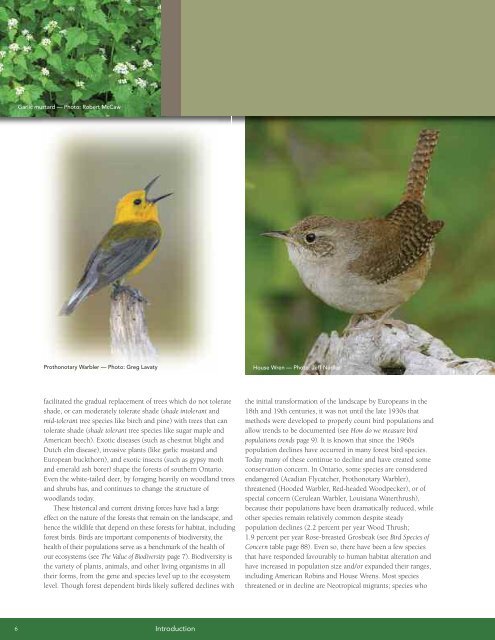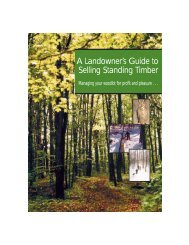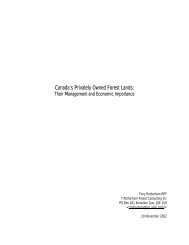A land manager's guide to conserving habitat for forest birds in ...
A land manager's guide to conserving habitat for forest birds in ...
A land manager's guide to conserving habitat for forest birds in ...
Create successful ePaper yourself
Turn your PDF publications into a flip-book with our unique Google optimized e-Paper software.
Garlic mustard — Pho<strong>to</strong>: Robert McCaw<br />
Prothonotary Warbler — Pho<strong>to</strong>: Greg Lavaty<br />
House Wren — Pho<strong>to</strong>: Jeff Nadler<br />
facilitated the gradual replacement of trees which do not <strong>to</strong>lerate<br />
shade, or can moderately <strong>to</strong>lerate shade (shade <strong>in</strong><strong>to</strong>lerant and<br />
mid-<strong>to</strong>lerant tree species like birch and p<strong>in</strong>e) with trees that can<br />
<strong>to</strong>lerate shade (shade <strong>to</strong>lerant tree species like sugar maple and<br />
American beech). Exotic diseases (such as chestnut blight and<br />
Dutch elm disease), <strong>in</strong>vasive plants (like garlic mustard and<br />
European buckthorn), and exotic <strong>in</strong>sects (such as gypsy moth<br />
and emerald ash borer) shape the <strong>for</strong>ests of southern Ontario.<br />
Even the white-tailed deer, by <strong>for</strong>ag<strong>in</strong>g heavily on wood<strong>land</strong> trees<br />
and shrubs has, and cont<strong>in</strong>ues <strong>to</strong> change the structure of<br />
wood<strong>land</strong>s <strong>to</strong>day.<br />
These his<strong>to</strong>rical and current driv<strong>in</strong>g <strong>for</strong>ces have had a large<br />
effect on the nature of the <strong>for</strong>ests that rema<strong>in</strong> on the <strong>land</strong>scape, and<br />
hence the wildlife that depend on these <strong>for</strong>ests <strong>for</strong> <strong>habitat</strong>, <strong>in</strong>clud<strong>in</strong>g<br />
<strong>for</strong>est <strong>birds</strong>. Birds are important components of biodiversity, the<br />
health of their populations serve as a benchmark of the health of<br />
our ecosystems (see The Value of Biodiversity page 7). Biodiversity is<br />
the variety of plants, animals, and other liv<strong>in</strong>g organisms <strong>in</strong> all<br />
their <strong>for</strong>ms, from the gene and species level up <strong>to</strong> the ecosystem<br />
level. Though <strong>for</strong>est dependent <strong>birds</strong> likely suffered decl<strong>in</strong>es with<br />
the <strong>in</strong>itial trans<strong>for</strong>mation of the <strong>land</strong>scape by Europeans <strong>in</strong> the<br />
18th and 19th centuries, it was not until the late 1930s that<br />
methods were developed <strong>to</strong> properly count bird populations and<br />
allow trends <strong>to</strong> be documented (see How do we measure bird<br />
populations trends page 9). It is known that s<strong>in</strong>ce the 1960s<br />
population decl<strong>in</strong>es have occurred <strong>in</strong> many <strong>for</strong>est bird species.<br />
Today many of these cont<strong>in</strong>ue <strong>to</strong> decl<strong>in</strong>e and have created some<br />
conservation concern. In Ontario, some species are considered<br />
endangered (Acadian Flycatcher, Prothonotary Warbler),<br />
threatened (Hooded Warbler, Red-headed Woodpecker), or of<br />
special concern (Cerulean Warbler, Louisiana Waterthrush),<br />
because their populations have been dramatically reduced, while<br />
other species rema<strong>in</strong> relatively common despite steady<br />
population decl<strong>in</strong>es (2.2 percent per year Wood Thrush;<br />
1.9 percent per year Rose-breasted Grosbeak (see Bird Species of<br />
Concern table page 88). Even so, there have been a few species<br />
that have responded favourably <strong>to</strong> human <strong>habitat</strong> alteration and<br />
have <strong>in</strong>creased <strong>in</strong> population size and/or expanded their ranges,<br />
<strong>in</strong>clud<strong>in</strong>g American Rob<strong>in</strong>s and House Wrens. Most species<br />
threatened or <strong>in</strong> decl<strong>in</strong>e are Neotropical migrants; species who<br />
6<br />
Introduction

















